Denton Recipients of other Military Awards,
1914-1919
Albert Medal (AM)
The Albert Medal was instituted in 1866 and named after Queen Victoria's consort, Prince Albert, who had died in 1861. There were two classes: First Class in gold and Second Class in bronze. The medal was awarded only for the most exceptional bravery and consequently was very sparingly given. Until the institution of the George Cross in 1940 it was Britain's premier decoration for civilian acts of gallantry in saving life at sea and on land. It became known as 'the civilian's Victoria Cross', although awards were also made to servicemen in non-combatant situations. The medal was terminated in 1971 and holders of the Albert Medal could exchange their medals for the George Cross. This medal is of equal precedence to the Victoria Cross.

Albert Medal in bronze.
Canadian Royal Army Medical Corps,
attached Canadian Cavalry Field Ambulance
Lieutenant Colonel (Temporary Brigadier General) Alfred Burt DSO GOC
7th Cavalry Brigade
T/28996 Driver Alfred Edward Montague Horn
Army Service Corps, Heavy Transport,
attached H.Q. 7th Cavalry Brigade
DM2/096744 Private Arthur Johnson
Army Service Corps, Mechanical Transport,
attached 364th Forestry Company, Royal Engineers
Citation
On the 30 Jun 1918, a corporal of the Royal Air Force, who had been lowered by a rope into a crater caused by a bomb which had been dropped by a hostile aeroplane, was overcome by carbon monoxide gas,
which had accumulated in large quantities in the crater. Endeavours were made to haul him out, but his head became caught, and Private Johnson volunteered to descend and re-adjust the rope,
which he did successfully, and the corporal was rescued, but Johnson was himself overcome. Driver Horn at once put on his respirator and lowered himself to the rescue, but was likewise overcome.
Serjeant Brookes then volunteered to rescue both men, but was also overcome by gas; fortunately he was hauled out. At this stage Brigadier General Burt refused to permit anyone else to descend,
but did himself, and succeeded in dragging one of the unconscious men some way towards the rope; he, however, became unconscious and had to be pulled out.
There can be no doubt that they all knew the risk that they were running, and willingly incurred it in the hope of saving life.
Reference: The Canadian Gazette, 21 Dec 1918.
Location of the incident: Belloy-sur-Somme, France, 30 Jun 1918.
Driver Horn and Private Johnson both died on the 1 Jul 1918 as a result of their involvement and their awards were posthumous. They were buried in Crouy British Cemetery, Crouy-sur-Somme, France. Grave References: III.C.25 and 26, respectively.
Victor Brookes was born at Gorton, Manchester, on the 28 Nov 1887 to Robert John Corby Brookes and Jane Greaves who were married at Chorlton-on-Medlock, Manchester, in 1887. He was baptised at St James’s Church, Gorton, on the 18 Jan 1888. He was in Canada at the outbreak of war and he enlisted in the army on the 10 Feb 1915 at Calgary, Alberta, and he became a stretcher bearer. He married Yvonne Brunel at Hangest-sur-Somme, France, in 1919. After being demobilised he was briefly resident on Balmoral Drive, Denton, before moving back to Gorton. The couple had two children, Allan Adrian (b. Gorton, 1924) and Yvette Isabelle (b. Openshaw, 1931). He died at Stockport on the 16 Oct 1974. He is commemorated on the George Cross Honours Board at the Union Jack Club, London, because the Albert Medal was subsequently replaced by the George Cross.
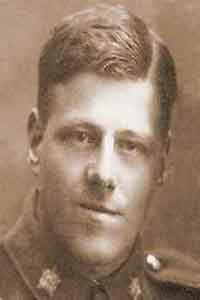
522653 Serjeant Victor Brookes AM.
Meritorious Service Medal (MSM)
The Meritorious Service Medal (MSM) was instituted by Royal Warrant on the 19 Dec 1845 for the British Army in recognition of meritorious service by Non-Commissioned Officers. Between 1916 and 1919, Army NCOs could be awarded the medal immediately for meritorious service in the field. They could also be awarded the medal for acts of non-combat gallantry. The medal for Royal Marines was instituted in 1849 for gallantry or for distinguished service. Between 1916 and 1919, Royal Marine NCOs could be awarded the medal in the field. The Royal Air Force version of the medal was instituted in 1918 for meritorious service not involving flight. The Royal Navy version of the medal was instituted in 1919, for gallantry not in the face of the enemy and for meritorious service by petty officers and senior naval ratings. It is now awarded to senior NCOs in the Royal Navy, Royal Marines, Women's Royal Naval Service and Queen Alexandra's Royal Naval Nursing Service.
This award was notified without an accompanying citation describing the circumstances in which the Meritorious Service Medal was gained.
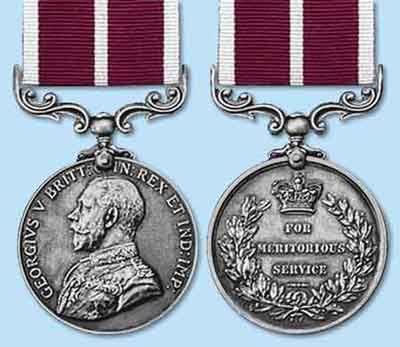
Meritorious Service Medal.
Citation
For services in cruisers employed on escort, convoy, and patrol duties during 1917 and 1918.
Reference: The London Gazette, Supplement 31182, Page 2360, 14 Feb 1919.
The duties of Writers in the Royal Navy were primarily clerical, being responsible for legal, pay, welfare and career issues for a crew. A 3rd Writer is equivalent to the rank of Ordinary Seaman. In action they were utilised in damage control parties. The name of the ship (or ships) that John Lloyd Birch served on is unknown.
John Lloyd Birch was born at Padiham, Lancashire, on the 31 Dec 1894 to John Birch and Isabella Hamer who were married at Holcombe Emmanuel Church, Holcombe Village, north of Bury, in 1885. In 1911 he was resident with his parents and brother, Samuel Herbert (21), on Gorton Rd, Reddish, employed as a clerk at a newspaper publisher. After he was demobilised in Jul 1919 he was resident on Balmoral Drive, Denton. He married Rose Halcomb Lee (b. 3 Apr 1904) in the Bucklow (Altrincham) Registration District in 1928. In 1939 he was resident with his wife and daughter, Gillian, on Mossgrove Ln, Timperley, Cheshire, employed as the company secretary and executive director of a company of worsted spinners, woollen yarns and needle works manufacturers. During the Second World War he was an ARP Warden.
Royal Field Artillery, 20th Divisional Ammunition Column
Reference: The London Gazette, Supplement 31132, Page 972, 17 Jan 1919.
William Burrill was born at Moss Side, Manchester, in 1896 and after being demobilised he was resident on Hyde Rd, Denton.
Royal Engineers
Additionally served in the Royal Army Service Corps
Also Mentioned in Despatches (MID)
Granted an Honorary Commission in the Royal Air Force
as a Second Lieutenant (now Pilot Officer) on the 1 Apr 1919
References:
MSM: The London Gazette, Supplement 30450, Page 68, 28 Dec 1917.
MID: The London Gazette, Supplement 29890, Page 216, 2 Jan 1917.
Honorary Commission: The London Gazette, Issue 31472, Page 9432, 25 Jul 1919.
Jesse Peters Clark was born at the Worksop District in 1891 and after being demobilised he was resident on Howard Ln, Denton.
of the 56th Labour Company of the Labour Corps,
formerly 24108 of the 18th Battalion, Cheshire Regiment
and 37678 of the 12th Battalion, Border Regiment
References:
The London Gazette, Supplement 30750, Page 7156, 17 Jun 1918.
The 18th (Labour) Battalion of the Cheshire Regiment was raised in Oldham and it moved to France on the 3 Apr 1916. Subsequently, this battalion was converted into the 56th Labour Company of the Labour Corps. He was discharged from the army on the 13 Dec 1918, as he was no longer physically fit for military service.
Fred Worthington Lowe was born at Denton on the 13 Sep 1891 to John Worthington and Sarah Elizabeth Lowe who were married at Ashton-under-Lyne in 1894. In 1911 he was resident with his parents and siblings on Highfield St, off Frederick St, Denton, employed as a felt hat shaper. He married Elizabeth Wareing at the Methodist Church, Hooley Hill, Audenshaw, on the 29 Mar 1916. After the war the family was resident on Clare St, off Ashton Rd, Denton, where he started to use the name, Fred Worthington.
He became the Joint General Secretary of the hatting unions as well as being a long-term Denton Councillor, who was Chairman of Denton Urban District Council on four occasions, 1928-29, 1929-30, 1930-31 and 1955-56. During the Second World War he was an ARP Warden. He also served as a Justice of the Peace and as a Deputy Lieutenant. In 1954 he was awarded the OBE. He died at Ashton-under-Lyne Hospital on the 15 Jun 1973, aged 81 years.
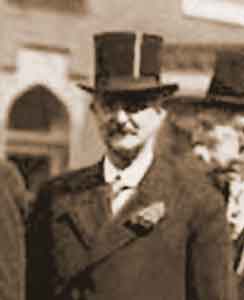
Fred Worthington JP DL OBE.
General Service Medal (GSM)
This medal was instituted in 1918 to recognise service in minor Army and Royal Air Force operations for which no separate medal was intended. Local forces, including police, qualified for many of the clasps, as could units of the Indian Army.
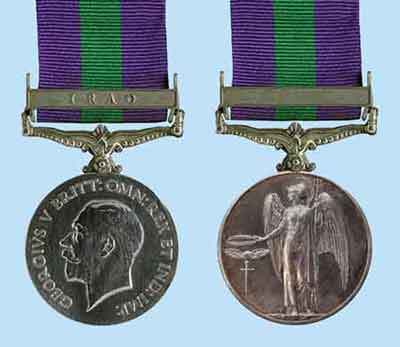
General Service Medal.
2nd Battalion, Manchester Regiment
Fred Williams joined the army in 1918 shortly after his 18th birthday and served with the Manchester Regiment but he did not go overseas before the end of the First World War. When the war ended he could have chosen to be demobilised but instead he volunteered to stay on for a further 27 months. Consequently, on the 28 Feb 1919 he re-enlisted and for a time he was at Scarborough in Yorkshire. This suggests that he was a member of the 5th (Reserve) Battalion. He was then posted to the 2nd Battalion and in Nov 1919 this moved to Ireland but in Feb 1920 the battalion received orders to mobilise for active service in Mesopotamia (Iraq). Between Apr and Jul 1920 the Battalion was based at Tikrit and then it moved to Hillah. On the 24 Jul 1920 the battalion was about 20 miles outside Hillah when it was attacked by Arab tribesmen. They managed to hold off their attackers until dusk at which point “D” Company was ordered to hold the position to allow the rest of the Battalion to withdraw. During the action there were casualties and 79 soldiers were taken prisoner to be released in Oct 1920. On the 26 Dec 1920 the 2nd Battalion left Mesopotamia and moved to Kamptee in India.
Fred Williams was awarded a General Service Medal, with a clasp for Iraq, in recognition of his service there. He was demobilised at the termination of his engagement on the 18 May 1921.
He was born at Denton on the 25 Mar 1900 to John Thomas Williams and Elizabeth Sale who were married at St Thomas’s Church, Heaton Norris, Stockport, in 1879. In 1911 he was resident with his widowed mother and siblings on Grosvenor St, Denton, still at school. When he was demobilised he returned to Grosvenor St. He married Lena Bolton (b. 28 Jun 1899) at St Aiden’s Church, Bradford, Manchester, on the 12 Aug 1923 and they were resident on Ryder St, Bradford. By 1939 he was resident with his wife and family on Broadway, Bredbury, Cheshire, employed as a hatter.
Military Cross (MC)
The Military Cross (MC) was instituted by Royal Warrant on the 28 Dec 1914 for officers of the rank of Captain or below, including Warrant Officers, in recognition of acts of gallantry. In Aug 1916 bars were awarded in recognition of the performance of further acts of gallantry meriting this award.
The award was notified without an accompanying citation describing the circumstances in which the Military Cross was gained.

Military Cross.
Highland Light Infantry
Reference: The Edinburgh Gazette, Issue 13033, Page 31, 1 Jan 1917.
Robert Dallas Blackledge was born at Ardwick, Manchester, on the 9 Oct 1891 to the Reverend Robert Thomas Blackledge MA and Ellen Dallas who were married at St Paul’s Church, Preston, in 1888.
He was resident on Manchester Rd, Denton. On the 23 Jul 1921 he dedicated the Denton War Memorial in Victoria Park in his capacity as the Curate of Christ Church.
Special Reserve, attached to the 1st Battalion, Coldstream Guards
Citation
For conspicuous gallantry. After an intense bombardment by the enemy, which demolished parts of his trench, and during which he was himself twice buried, he rallied the men round him and drove out a party of the enemy which had penetrated into the trench.
Reference: The London Gazette, Supplement 29602, Page 5408 30 May 1916.
Frank Thewlis was born at Gorton, Manchester, in 1890 to Joseph Thewlis and Elizabeth Embelow White who were married at St James’s Church, Birch-in-Rusholme, Manchester, in 1889. In 1901 he was resident with his parents and siblings on Woodhouse St, Gorton, still at school. Subsequently his father died and his widowed mother was resident on Laburnum Rd, Denton.
He qualified as a solicitor and he trained to be an officer with the Inns of Court Officer Training Corps. He first entered the Theatre of War in the Balkans on the 14 Jul 1915 but afterwards he was posted to France. At this point he was the commander of the 11th Platoon, No. 3 Company of the 1st Battalion Coldstream Guards. He was killed in action at Ginchy, which lies between Bapaume and the river Somme, on the 15 Sep 1916, aged 26 years, and he is commemorated on the Thiepval Memorial, France, Pier & Face 7D & 8D.
Lieutenant Frank Thewlis was aided by 14870 Lance Corporal Thomas Tarmey who survived the action but was wounded. He was born in the Colne District of Lancashire in 1892. He enlisted in the army on the 16 Jan 1915 and he was discharged on the 15 Sep 1917 due to a crushed spine and chronic nephritis. He was awarded Silver War Badge No. 133197.
21st Battalion, Manchester Regiment
formerly B/1435 Corporal (then Serjeant) George Henry Tomkinson
of the Rifle Brigade
The 21st Battalion was one of the ‘Manchester Pals’ battalions. George Henry Tomkinson was resident on Thornley Ln, which formed the boundary between Denton and Reddish.
Mentioned in Despatches (MID)
This is a commendation of an act of gallantry. It arises when an individual is mentioned by name and commended for having carried out a noteworthy act of gallantry or service. A Despatch is an official report written by the senior commander in the field. In 1919 it was decided that individuals 'Mentioned in Despatches' will receive a certificate and in 1920 a decoration in the form of a bronze oak leaf was introduced. This was usually sewn onto the ribbon of the British Victory Medal.

MID Bronze Oak Leaf.
“A” Company, 8th Battalion, King’s Own (Royal Lancaster Regiment)
Mentioned twice
First MID Reference: The London Gazette, Supplement 29890, Page 220, 2 Jan 1917.
Second MID Reference: The London Gazette, Supplement 30086, Page 5025, 22 May 1917.
Samuel Howard was killed in action on the 10 May 1917, aged 25 years, and was buried in Faubourg D'amiens Cemetery, France. Grave Reference: V.E.1.
He was resident on Mount Pleasant Rd, Denton.
"A" Battery, 66th Brigade, Royal Field Artillery
(Served as Henry H Iles, CWGC give his Service No. as 5394)
Reference: His Medal Card records that he was posthumously Mentioned in Despatches on the 19 Oct 1916.
He was killed in action on the 22 Apr 1916, aged 23 years, and he is commemorated on the Basra Memorial, Iraq, Panel 3 and 60. Herbert Henry Iles was born at Denton in 1893 to Henry Fredeick Iles and Sylvia Broughton.
Prior to enlisting he was resident with his parents and siblings on St Martin St, Castleton, Rochdale, employed as a fitter.
Machine Gun Corps
formerly 2631 Serjeant Thomas Henry Pickles of the
11th Battalion, Manchester Regiment
Reference: The London Gazette, Supplement 29890, Page 241, 2 Jan 1917.
Thomas Henry Pickles survived the war to be demobilised and he was resident on Catherine St, Denton.
2/2nd East Lancashire Field Ambulance, Royal Army Medical Corps
formerly 242 and 881
Reference: The London Gazette, Supplement 31446, 8 Jul 1919
Fred Redhead survived the war to be demobilised and he was resident in Chorlton-cum-Hardy. He was born at Denton in 1891 and later he moved with his parents to Heaton Moor, Stockport.
Royal Engineers
Reference: The London Gazette, Supplement 30740, Page 6920, 7 Jun 1918.
Fred Shaw survived the war to be demobilised and he was a Denton resident.
Croix de Guerre (Belgium)
This is a military decoration of the Kingdom of Belgium established by royal decree on 25 Oct 1915. It was primarily awarded for bravery or other military virtue on the battlefield.
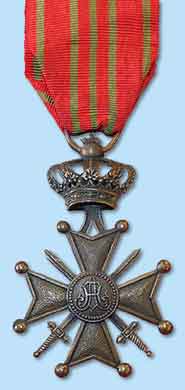
Croix de Guerre (Belgium).
Royal Marines (Royal Naval Division Medical Unit)
Reference: The Edinburgh Gazette, Issue 13323, Page 3502, 20 Sep 1918.
Harry Bardsley survived the war to be demobilised and he was resident on Hyde Rd, Denton.
Royal Field Artillery
Reference: The London Gazette, Supplement 30631, Page 4532, 12 Apr 1918.
James Glover survived the war to be demobilised and he was resident on Park Rd, Denton.
Territorial Force Efficiency Medal
The Territorial Force Efficiency Medal was introduced in 1908. It was presented for long service and was awarded to non-commissioned officer and men who had completed 12-years service in the Territorial Force. War service counted as double for the purpose of determining eligibility for the medal. Bars were awarded to recognise further periods of 12-years qualifying service.
This medal superseded the Volunteer Long Service and Good Conduct Medal when the Territorial Force was formed in 1908 following the enactment of the Territorial and Reserve Forces Act 1907. This Act resulted in a large re-organisation of the old Volunteer Army and the remaining units of Militia and Yeomanry.
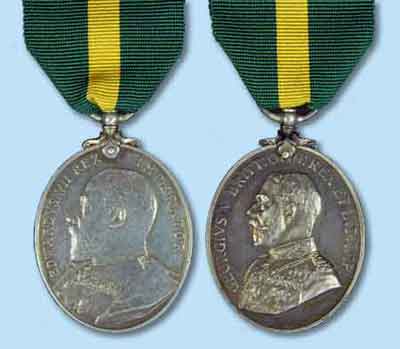
Right: King George V.
The reverse of the medal is inscribed:
9th Battalion, Manchester Regiment
formerly 1199 then 350103 Serjeant Thomas Radcliffe
Thomas Radcliffe survived the war and his Medal Rolls Index Card records that he was also awarded the Victory Medal and the British War Medal. The card also gives the address of the 9th Battalion, Manchester Regiment, as the Castle Armoury, Old St, Ashton-under-Lyne.
He was born at Denton in 1892 and in civilian life he was a felt hat body maker resident with his widowed mother on Wilde St, Denton. He is the son of David Benjamin Radcliffe and Mary Elizabeth Bardsley who were married at Christ Church, Ashton-under-Lyne, in 1887. David Benjamin Radcliffe died at Denton in 1902, aged 35 years.
Territorial Force War Medal
This campaign medal is one of the least known of the Great War. It was introduced in 1920 and 33,944 were awarded to those serving in Territorial Force Battalions and the Territorial Force Nursing Service.
The conditions were that it was awarded to those who were serving with a Territorial Force Battalion on the 4 Aug 1914 or to those who had completed four-years service prior to the 4 Aug 1914. Additional conditions were that a recipient had to have volunteered to serve outside the United Kingdom prior to 30 Sep 1914, had actually served outside the United Kingdom between the 4 Aug 1914 and 11 Nov 1918 and were not eligible for the award of a 1914 or 1914-15 Star (Mons Star).
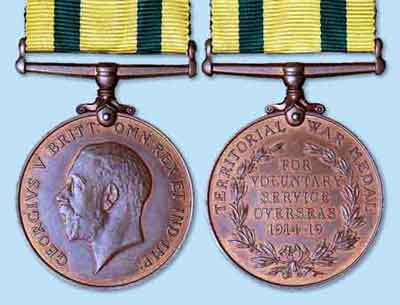
Territorial Force War Medal.
9th Battalion, Manchester Regiment
John Wright Cooke was killed in action on the Somme battlefields on the 23 Mar 1918, aged 22 years, the second day of the German Spring Offensive that was launched on the 21 Mar 1918 and continued until midnight on the 7 Aug 1918.
He was born at Denton in 1896 to George Edward Cooke and Marry Ellen Bowler who were married at St Mark's Church, Bredbury, in 1887. Prior to the war he was resident with his parents on Ashton Rd, Denton.
18th Battalion, Manchester Regiment
formerly 100 Corporal Harry Duncan
of the Royal Army Medical Corps
Harry Duncan was killed in action on the 23 Apr 1917, aged 25 years, during the Battle of Arras, France, fought between the 9 Apr and 16 May 1917.
He was born at Denton in 1891 to George Duncan and Rose Haigh who were married at Christ Church, Denton, in 1891. Prior to the war he was resident with his parents on Cross St, Denton.
Card of Honour
Little is known about the Card of Honour or how widespread its use was. This award was a certificate acknowledging conspicuous service. It was awarded by a divisional commander on the recommendation of a brigade commander. It was similar to being Mentioned in Despatches but without being an official report written by a senior commander in the field. Consequently, these awards were not recorded in the London Gazette.
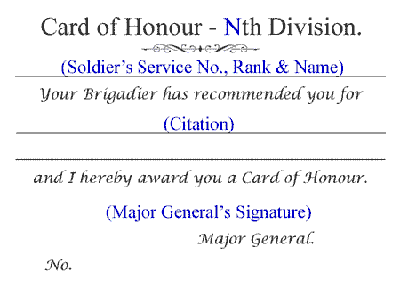
Facsimile of a Card of Honour.
20th (Tyneside Scottish) Battalion, Northumberland Fusiliers
It is known that he was a trench runner operating under enemy fire and that he died of wounds on the 25 Nov 1917, aged 32 years. He is buried in Bucquoy Road Cemetery, France.
Although the army division he was serving with and the details of the citation on his Card of Honour are unknown, the citation would be similar to the following:
For conspicuous service rendered as a trench runner on (date).
Trench runners were identifiable by red arm bands fixed around their left forearm. The responsibilities of runners were not simply to bear messages between command units as it also included other tasks requiring specialised knowledge. Their missions were both critical and perilous. Runners would be required to familiarise themselves with areas of the front line into which fresh troops would soon enter, usually in order to relieve the present occupants of the lines. In order to accurately guide fresh troops, especially because many such troop movements were undertaken under cover of darkness, runners were required to excel at map reading and reconnaissance. While undertaking this they often worked in pairs and there could be several pairs working upon the same task at different parts of the lines. Speed and accuracy were, therefore, essential to ensure that the relieving troops were all in place before daylight, that is, before the enemy could catch troops in the open with artillery fire.
Henry Hubert Shaw was born at Nantwich, Cheshire, in 1885 to Charles Shaw and Ellen Brown who were married at Nantwich in 1884. In 1901 he was resident with his parents and siblings on Osborne Rd, Denton. He married Amelia Ellor at Ashton-under-Lyne in 1910 and in 1911 he was resident with his wife on Acre St, Denton, employed as a felt hat finisher. Later his widow was resident on Holland St.
